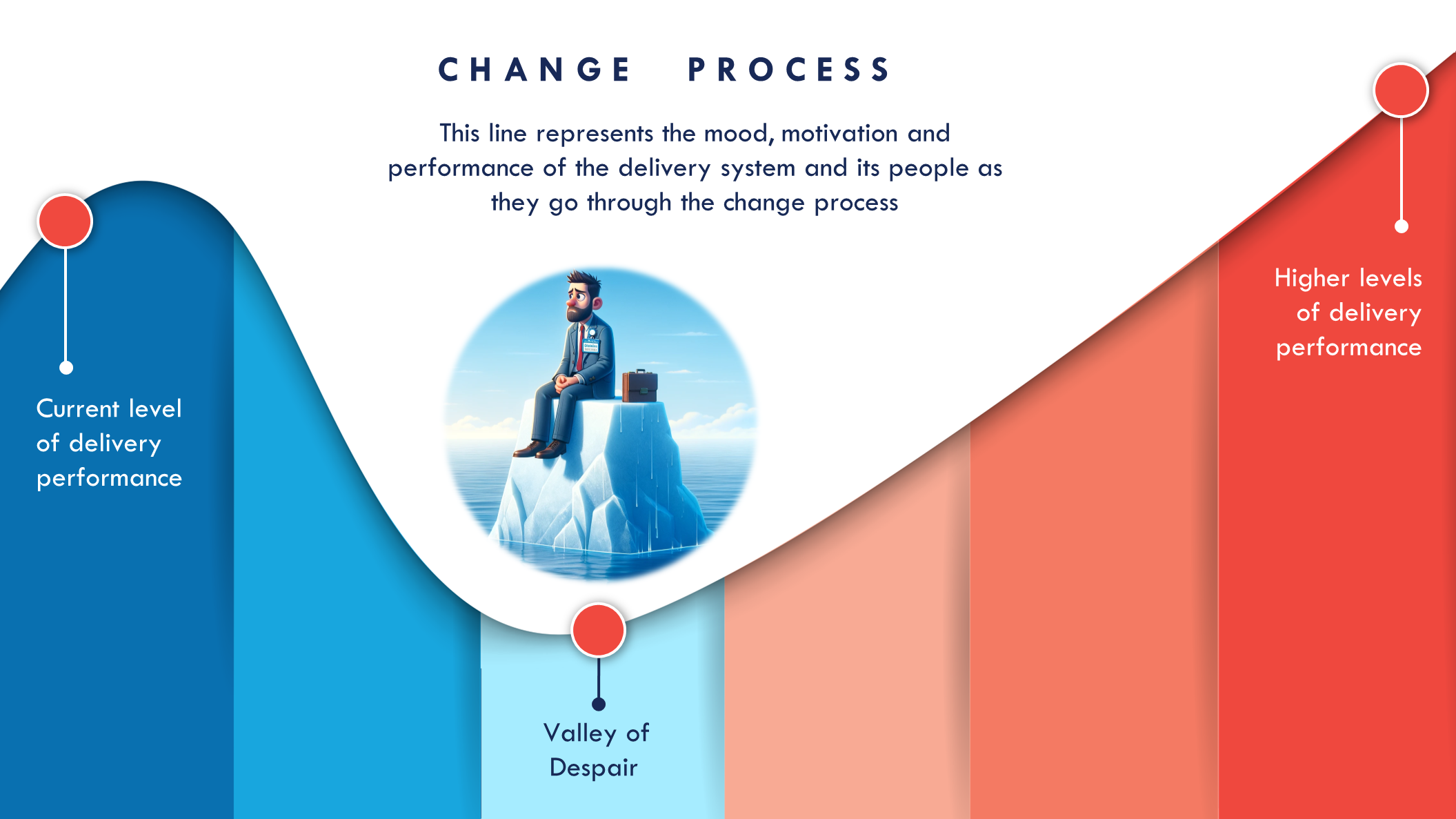
The Curse of Half-adopted Agile
In recent years, agile methodology has solidified its status as more than just a fleeting trend in the world of project management and software development. Its principles and practices have been widely adopted across various industries, signaling a significant shift towards a more flexible, iterative approach to work. However, while agile has convincingly won the argument about its permanence and effectiveness, the journey toward full implementation is fraught with challenges. Many organizations find themselves caught in a precarious position – having adopted only the superficial aspects of agile, they end up stranded in what John Fisher's Change Curve refers to as the "valley of despair."

The valley of despair is a critical phase in the change curve, marked by low morale, productivity, and confidence in the new system. This phase is particularly pronounced in organizations that have implemented agile in piecemeal or half-hearted ways. By choosing to adopt only the "easy" parts of agile—such as sprints, stand-ups, and scrum meetings—these organizations miss out on the deeper, more transformative aspects of the methodology. This selective adoption leads to a pseudo-agile state, where the appearance of agility masks a lack of substantive change in the organization's core processes and culture.
The Half-Implemented Methodology: A Path to Nowhere
Agile's true power lies in its holistic approach to project management and product development. It is not merely a collection of tools and practices but a mindset that emphasizes flexibility, customer-centricity, and continuous improvement. However, when organizations opt for an à la carte approach to agile, cherry-picking the practices that seem easiest to implement, they inadvertently set themselves up for failure. This selective adoption creates a mismatch between the organization's stated goals and the actual methodologies in place, leading to confusion, inefficiency, and a sense of stagnation.
Beyond the Valley: Embracing the Hard Parts of Agile
To fully reap the benefits of agile and navigate out of the valley of despair, organizations must be willing to tackle the more challenging aspects of the methodology. This includes:
**Proper Product Ownership**: Agile demands a shift in how roles and responsibilities are viewed, particularly the role of the product owner. This position becomes crucial, acting as the linchpin between the development team and the stakeholders. Proper product ownership ensures that the product vision is clearly defined, communicated, and pursued throughout the project lifecycle.
**Changing Funding Approaches**: Traditional funding models, which typically require detailed upfront planning and fixed budgets, are at odds with agile's iterative nature. Organizations must be willing to adopt more flexible funding approaches that allow for adjustments and pivoting based on feedback and changing market conditions.
**Genuine Customer-Centricity**: At its core, agile is about delivering value to the customer. This means going beyond lip service and making customer feedback and satisfaction a central element of the development process. It requires a cultural shift towards valuing what the customer truly needs over adhering to rigid project specifications.
The Path Forward
The journey towards becoming a truly agile organization is neither simple nor straightforward. It requires a commitment to change that goes beyond adopting the easy parts of the methodology. By embracing the more difficult aspects of agile, organizations can move beyond the valley of despair and towards a future where they are more responsive, efficient, and aligned with their customers' needs.
The transition requires patience, perseverance, and a willingness to embrace change at all levels of the organization. However, the rewards—increased agility, improved customer satisfaction, and greater competitive advantage—are well worth the effort. As we look to the future, it's clear that agile is here to stay. The question for organizations is not whether to adopt agile, but how fully and effectively they can implement its principles to achieve lasting success.
A Whiteboard Dialogue
At Source Agility we specialize in guiding organizations out of this valley and onto the path of meaningful, sustainable agile adoption. Our approach is centered on tackling the challenging aspects of agile transformation head-on.
Don't let partial implementation hinder your progress. It's time to realize the full potential of agile within your organization. Contact us today to learn how we can help you navigate beyond the valley of despair, transform your agile delivery performance, and achieve the agility your organization strives for.



